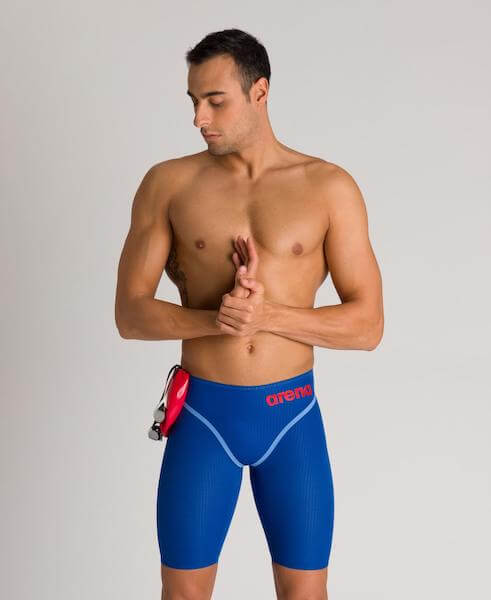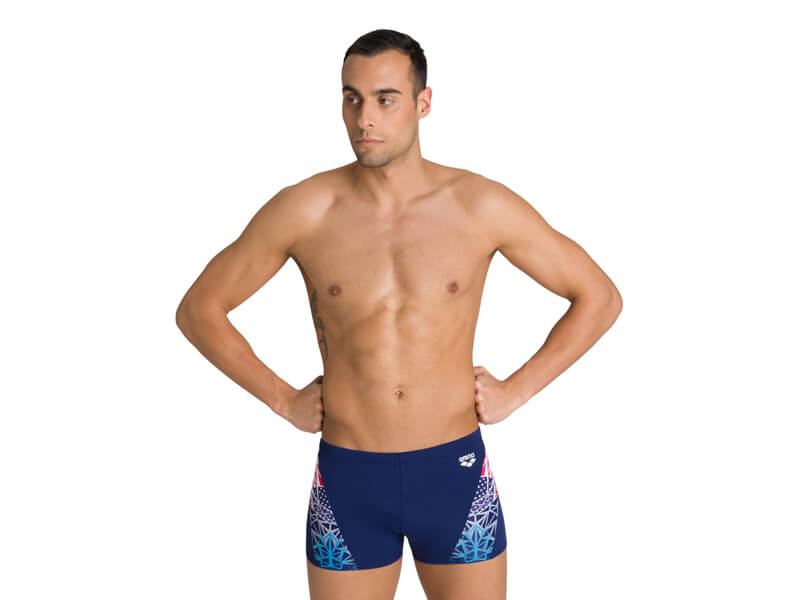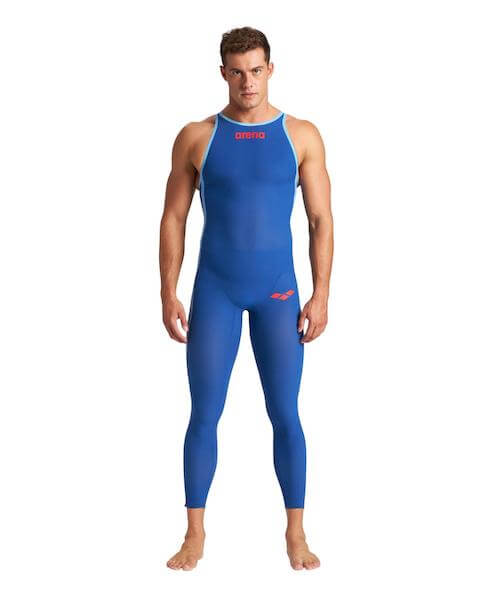Men’s Competition Swimsuits: How to Choose the Right Style
When you begin training for competitive swim events, it quickly becomes apparent that board shorts aren’t going to cut it. You’re going to need men’s swimwear that helps you move through the water better than your average swim trunks for competing.
Understanding the characteristics of different types of men’s competition swimsuits will help you choose the one that best fits your needs.
Each style of competition swimwear serves a specific purpose. Jammers and swim briefs, for example, are specifically designed for racing, as are suits used in open-water and triathlon swimming contests. Other suits are geared toward training, but they’re important to learn about since good training plays a crucial role in your competitive performance. We’ll also touch on the proper way to care for your swimwear.
Jammers: The Current Standard for Men’s Competition Swimsuits

If you watch any high-level men’s swim competitions, you’ll see them wearing jammers that have the latest swim technology packed into them. Ever since FINA banned polyurethane tech suits, jammers now represent the highest end of men’s competition swimsuits.
If you decide on a jammer swimsuit, you’ll want to choose between those designed for racing and jammers meant for training.
Jammers for Racing
If you already compete at a high level, you most likely own a pair of race-specific jammers. Or, if you want to take the next step as a swim racer and are looking to secure that record you’ve been chasing, then these suits are for you.
Jammer swimsuits are designed to reduce drag by compressing your legs and utilizing material that improves your glide through the water. They have special internal taping that makes it so the muscle groups in your legs can work together to generate optimal amounts of power while you swim. Racing jammers increase your buoyancy, further reducing drag and allowing you to swim faster.
The materials used in these men’s competition swimsuits are typically combinations of Lycra spandex, nylon, polyamide, elastodiene, or elastane. Materials like these allow for significant compression while reducing drag.
A suit like the arena Powerskin Carbon Glide Jammer provides you with the compression you need without sacrificing comfort, flexibility, and durability. This suit, in particular, is constructed using a carbon grid that covers your legs, giving you better compression where it matters most.
Make sure the racing suit you select is allowed for use in your competitions. According to the FINA Requirements For Swimwear Approval, swimsuits must be made of textile fabrics and meet various other requirements concerning flexibility, surface treatment, buoyancy, and permeability. All the men’s competition swimsuits at arena are FINA-approved.
A Note on the Fit of Race Suits
Race suits are notoriously difficult to get into, but it’s all worth it when you dive into the water and feel how efficiently you can move across the pool. With added buoyancy and reduced turbulence, you’ll feel that amazing gliding sensation right off the block and through the rest of your swim.
We recommend that your race suit should be one size smaller than what you wear to train in. Be sure to consider getting a pair of race suit gloves so you can have an easier time getting in and out of your suit.
Pros for Racing Jammers:
- The fastest FINA-approved suits around
- Improved leg compression
- Great drag reduction
- Increased buoyancy in legs
Cons for Racing Jammers:
- Expensive
- Can be hard to get on
- High-tech fabrics are more delicate than standard fabrics
Jammers for Training
If you’re just getting your feet wet with competitive swimming, you might be thinking those racing jammers are a bit expensive. While that money is well spent for elite swimmers, you can get away with spending less on training jammers if you’re new to the sport. Jammers for training will still serve you well in competition.
As the name implies, these suits are used for training, even by high-level swimmers, so this type of swim jammer will serve its purpose even as your competitive swim needs grow. You can be sure that a good pair of training jammers will last you a good deal of time.
While these suits won’t provide you with the same levels of compression and drag reduction as race suits will, they do have definite benefits. You will still have good hydrodynamics and speed when training in a solid jammer. For beginners, the fabrics used in these suits make them easier to wear and handle. Plus they are chlorine-resistant. These attributes make for a good men’s competition swimsuit, especially if you are new to the sport and are just beginning to race.
Pros for Training Jammers:
- Affordable
- Durable
- Chlorine resistant
- Good hydrodynamics and drag reduction
- Can still be used for races at certain levels of competition
Cons for Training Jammers:
- Not as fast as race suits
- Not as much compression
Swim Briefs: The Timeless Training Suit

Swim briefs are an excellent option for training. Depending on the level at which you compete, they also make for a good race suit as there is very little fabric to cause drag.
When looking into the swim brief, you’ll have three options: a traditional swim brief, a square leg swim short, and a drag suit. The variation in the types of swimming briefs is not much but there are some slight differences to consider.
The Traditional Swimming Brief
The traditional swimming brief is something you’re likely to see when you venture to your local swimming pool or swim practice. The practicality of this suit is what makes it so popular among swimmers. It reduces drag plenty enough to train in and will last a reasonable amount of time. These suits are very capable in races, especially if you aren’t competing at extremely high levels, and are a great choice to satisfy your need for a good men’s competition swimsuit.
Pros of Traditional Swimming Briefs
- Affordable
- Durable
- Chlorine resistant
- Limited fabric use reduces drag
- Can still be used in lower-level competition
Cons of Traditional Swimming Briefs
- Do not provide compression through the legs
- Not as buoyant as jammers
The Swimming Short
A square leg swim short is a good option if you like a more conservative fit than the traditional brief offers. This suit still has good hydrodynamics but will be slightly slower than the traditional brief due to the extra fabric.
Pros of Swimming Shorts
- More conservative design than regular briefs
- Great for training
- Durable
- Chlorine resistant
- Affordable
Cons of Swimming Shorts
- More fabric means more drag
- No compression in legs
- Not designed for racing
Drag Suits
Drag suits should be used for training purposes only. As you can tell by the name, the suit is designed to create drag by using loose-fitting mesh as the outside layer of the suit. It should be used in conjunction with other resistance training tools. Incorporating the use of a drag suit into your swimming routine can positively impact your performance when it comes time to compete.
Pros of Drag Suits
- A great option for training
- Increases drag when you want a more difficult swim set
Cons of Drag Suits
- Not for racing use
- You’ll need an additional suit to compete in
Men’s Competition Swimsuits for Open-Water Events

Swimwear for open-water swimming is different from the suits used for pool swimming. Just as triathletes and open-water swimmers opt to use specific goggles for their events, they choose to use specific swimwear as well.
If you are new to open-water swimming or triathlons, you will need a quality swimsuit to meet the demands of these events. A rashguard and board shorts might work well for a leisure day at the beach but would make for a long and challenging swim. So, let’s take a look at your options for an open-water race suit.
When selecting what type of swimwear you need for your open-water events, you should decide between an open-water race suit and a wetsuit.
Open-water Race Suits
An open water suit can be swimwear that is just pants covering the legs or a suit covering the whole body except the arms. These suits are designed to increase your stability in the water, improve buoyancy, and provide excellent compression to keep your body as hydrodynamic as possible. If speed and mobility are your main concerns and water temperature is not too low, you should choose this suit.
Pros for Open- Water Race Suits
- Provide optimal speed for open-water events
- Improve buoyancy and stability
- Provide excellent compression for streamlined swimming
- Allow for great mobility and range of motion
- Choices between pant only suits and bodysuits
Cons for Open-water Race Suits
- Won’t keep you warm in cold water
Competition Wetsuits
A wetsuit for open-water swimming is designed to keep you warm in cold conditions. These suits also provide similar benefits to the ones mentioned above, including being more buoyant and capable of swimming faster. Depending on how cold the water is and how much natural range of motion you want out of your stroke, you can choose between full-body wetsuits or sleeveless wetsuits.
Pros for Competition Wetsuits
- Keep you warm in cold water
- Provide buoyancy and stability
- Choices between full-body coverage and sleeveless suits
Cons for Competition Wetsuits
- Thicker material limits range of motion
Swimsuit Care Is Important
You must take good care of your men’s competition swimsuits if you want them to last. Follow these steps to ensure you can get the most out of your new suits:
- Always rinse your suit with fresh water after each use.
- Don’t keep your wet swimsuit in a bag for extended periods.
- Do not leave your wet suit in a hot place like your car or swim bag.
- Wash with delicate fabric detergent.
- Air-dry the suit, not in direct sunlight.
Time To Enjoy Your New Swimsuit
Now that you have a better idea of which men’s competition swimsuits will fit your needs best, it’s time to get out there and use it! You just might decide you need more than one as your love of swimming grows.
Whether you think the speedy racing jammers are for you, or you prefer the durability and longevity of training suits, every swimsuit has its place in the water. Just be sure to take good care of your new swimsuit, so it sees you through many training sessions and races to come.
Check out more swimming gear by visiting the arena store online, from swim caps to keep you moving fast to T-shirts and parkas for when you’re in between sets.
Written by:
Harrison Howarth
Harrison is a freelance writer with a background in competitive aquatic sports. His love for water polo and swim, combined with his passion for writing and education, drives him to continue teaching and inspiring individuals to participate in aquatics.







